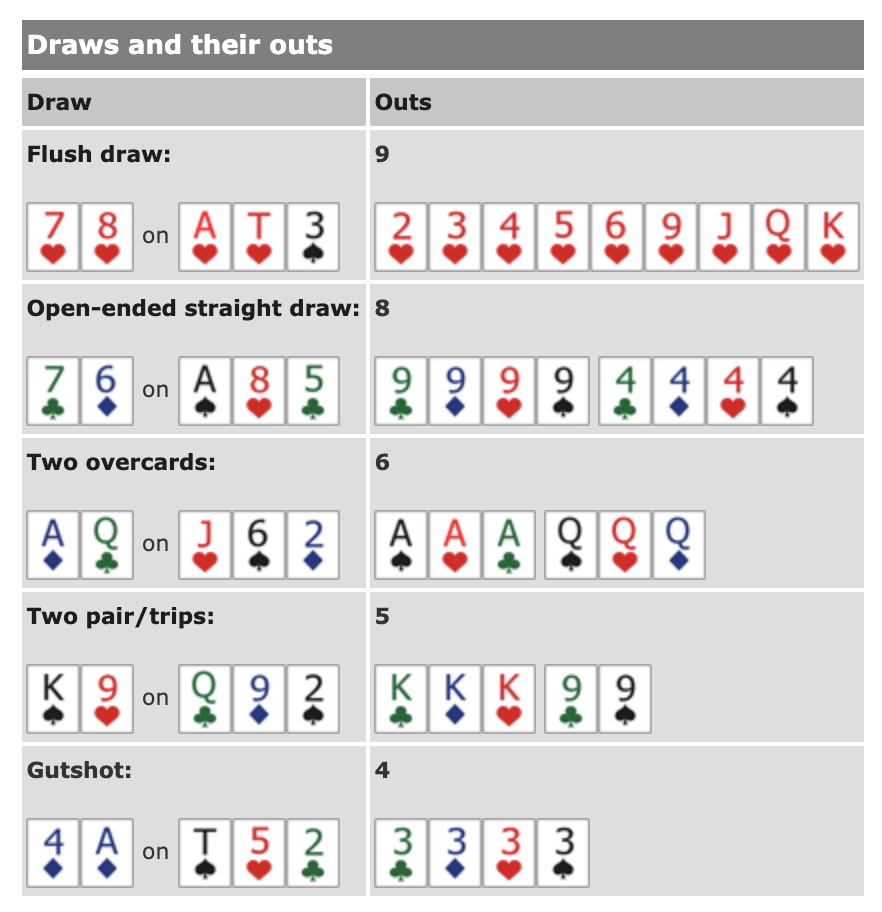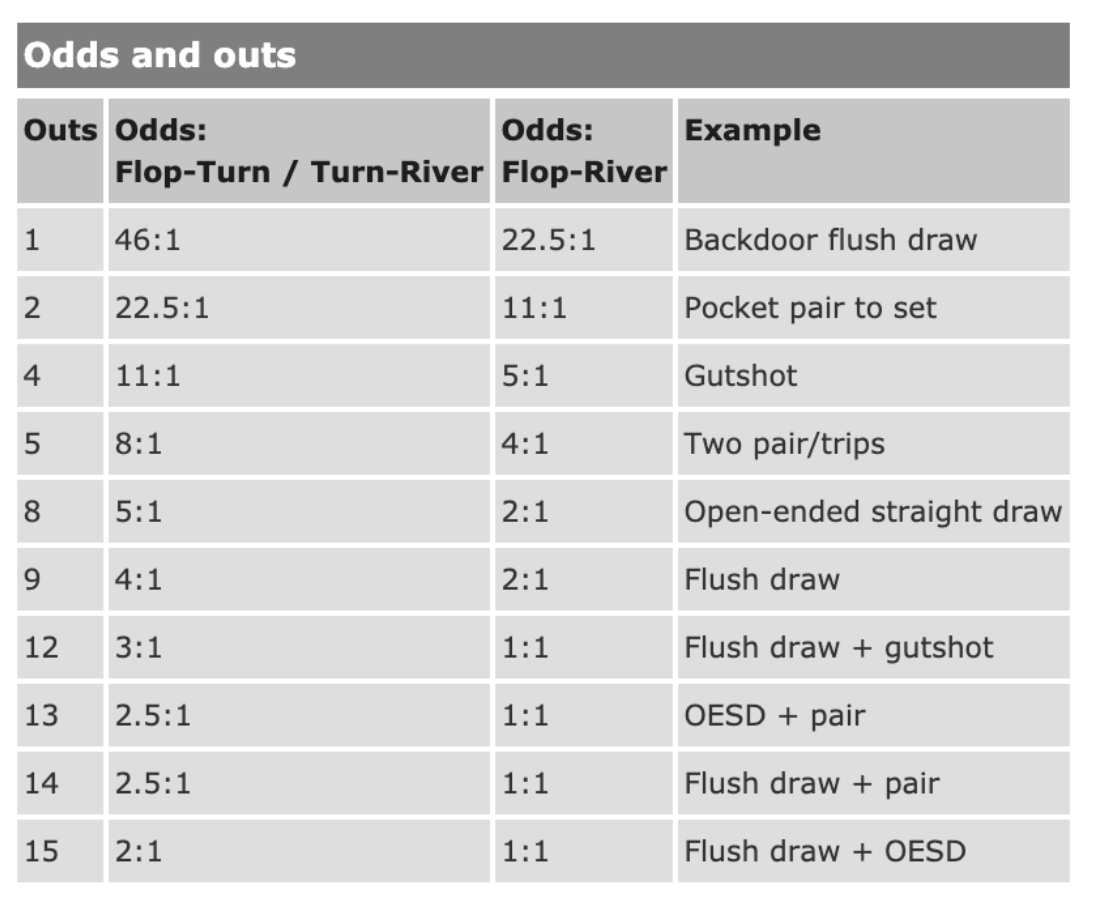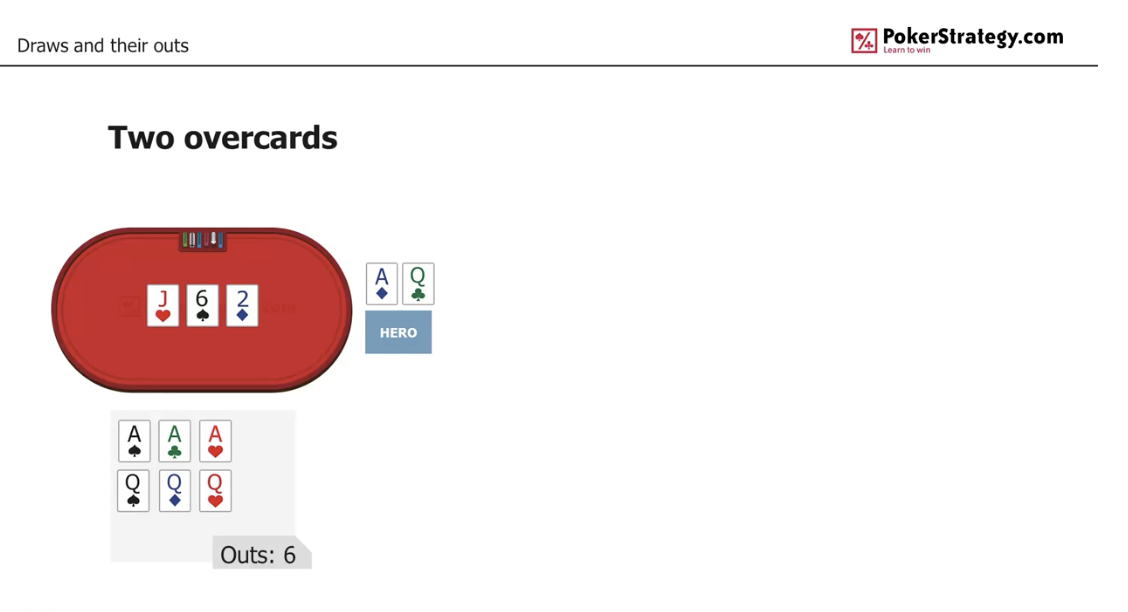For the newbies and those wanting to brush up on the fundamentals an important lesson on how to play drawing hands properly.
In poker, you are often behind with an incomplete hand, but you still have the chance to surpass the hand of your opponent. On the turn or river you need one card, which improves your hand into a made hand, e.g. into a flush or a straight.
A card that makes a draw into a made hand is called an out. When such a card appears on the turn or river, it is called “hitting an out”.
In this lesson, you will learn how to determine the probability to hit an out. These are called odds. You will learn how to calculate if you can profitably call a certain bet of your opponent with a certain draw using odds & outs as per the chart below.
Outs improve draws into made hands
It is called a draw, when you probably do not hold the best hand after the flop, but still have realistic chances to improve your hand into the best one. Typical draws are flush draws or straight draws. The cards that complete your draw are called outs.
Example: You hold 8h7h and the flop is AhTh3s. You have a flush draw. Every heart on the turn gives you a flush. The deck includes 13 hearts. Two of them are in your hand and two are in the flop. So there are nine hearts remaining, that can give you a flush on the turn. This means you have nine outs.

The more outs a draw has, the stronger it is. Remember only to count those cards as outs that really improve your draw into the best hand with a high probability. If an 8 appears on the turn in this example, then your hand improves into a pair, but it is anything but sure, that you will be ahead with this holding.

Texas Hold’em odds are the probability to hit an out
In order to be able to make the right decision with your draw you need to know the probability to hit an out on the turn or the river. This is calculated as follows:
- Step 1: Determine the number of outs, that complete your draw
- Step 2: Divide the number of your outs by the number of possible cards that might appear on the next street
Back to the example: You hold 8h7h on the flop AhTh3s and you have a flush draw. You already know that you have nine outs by this. In the next step you have to divide the number of your outs by the total number of turn cards.
The deck has 52 cards. Five of these are already known to you. Two of them you hold in your hand and three are in the flop. So there are 47 unknown cards left that can appear on the turn. So the probability to get the flush on the turn is:
9 outs / 47 possible cards = 0,19 = 19% ~ 4 to 1.
The probability is called odds. In Texas Hold’em, odds are regularly given in the notation “x to y”. A probability of 19% means that you will hit an out on the next street in about one out of five cases. This is given by “4 to 1”. An average there are four misses opposed to one hit.
In the following chart you find poker odds for typical situations. It also includes Texas Hold’em odds from the flop to the river. For example, these are important in an all-in situation, since in an all-in you will see the turn and river for sure.

Pot odds – Can I profitably play my hand?
Pot odds are the ratio of the possible reward compared to the stake you have to place when confronted with a bet. Thus they can be seen as a risk/reward ratio. By comparing the pot odds with your odds, you can estimate if a stake for a draw is worth it.
Again, we take a look at the example:

Your required stake is $2, the pot previous to the bet is $8, your possible reward is $10. The odds to hit your flush are about 4:1 against you.
Let us assume that in this case you will win the hand. This means that in one of these 5 cases you win $12. In the other four cases you will lose $2 respectively. Again under the assumption that you have to fold your hand on the turn if you can not improve it.
When you call the $2, on average after five occasions you have lost $2 four times and won $10 once. Your total profit, which is calculated by profit – deficit, is thereby at $10 – $8 = $2.
For this reason in the long run, it will pay off to call your opponent’s bet in this situation. On average, you will win $0.40 (= $2 / 5 hands) every time.
Now we introduce the so-called pot odds. They give the ratio of the possible reward compared to the required stake, so they are a reward/risk ratio.
Pot odds = possible reward : needed stake
In the aforementioned situation, the pot contains $8. You have to add the $2 that are placed by your opponent which makes a total pot and a possible benefit of $10. You have to pay $2 to stay in the game and see the turn card. Therefore the pot odds are $10:$2 or 5:1.
Thus your pot odds are 5:1 and your odds are 4:1.
Now you have to consider the following rule: if the pot odds are higher than the odds of an incomplete hand, you will win in the long run. If they are lower, you will lose.
What would happen if your opponent bets $4 instead of just $2? The possible benefit would rise to $8 + $4 = $12. But at the same time, your pot odds would turn to $12:$4 which is a ratio of 3:1. Therefore it would not be profitable to call the bet, since your odds are 4:1 and your pot odds are lower than your odds. At this point you should fold your hand, otherwise you would lose in the long run.
Using poker odds & outs, you can calculate if you can profitably call a draw. Outs are cards which complete your draw. Odds are the winning probabilities to hit an out. In Texas Hold’em odds = outs / possible cards.
Pot odds give the ratio of a possible reward compared to the stake you have to place. They are produced by: pot odds = possible reward : stake. If the pot odds are higher than the odds of a hand, you will win in the long run. If they are lower, you will lose in the long run.
To learn more about the basics of odds and outs check out this article or watch the video below:
Related Resources
source https://casinonewsblogger.com/news-poker-basics-odds-outs/


_227efd42.jpg)
No comments:
Post a Comment